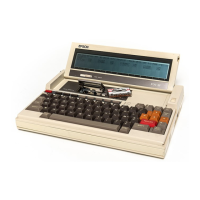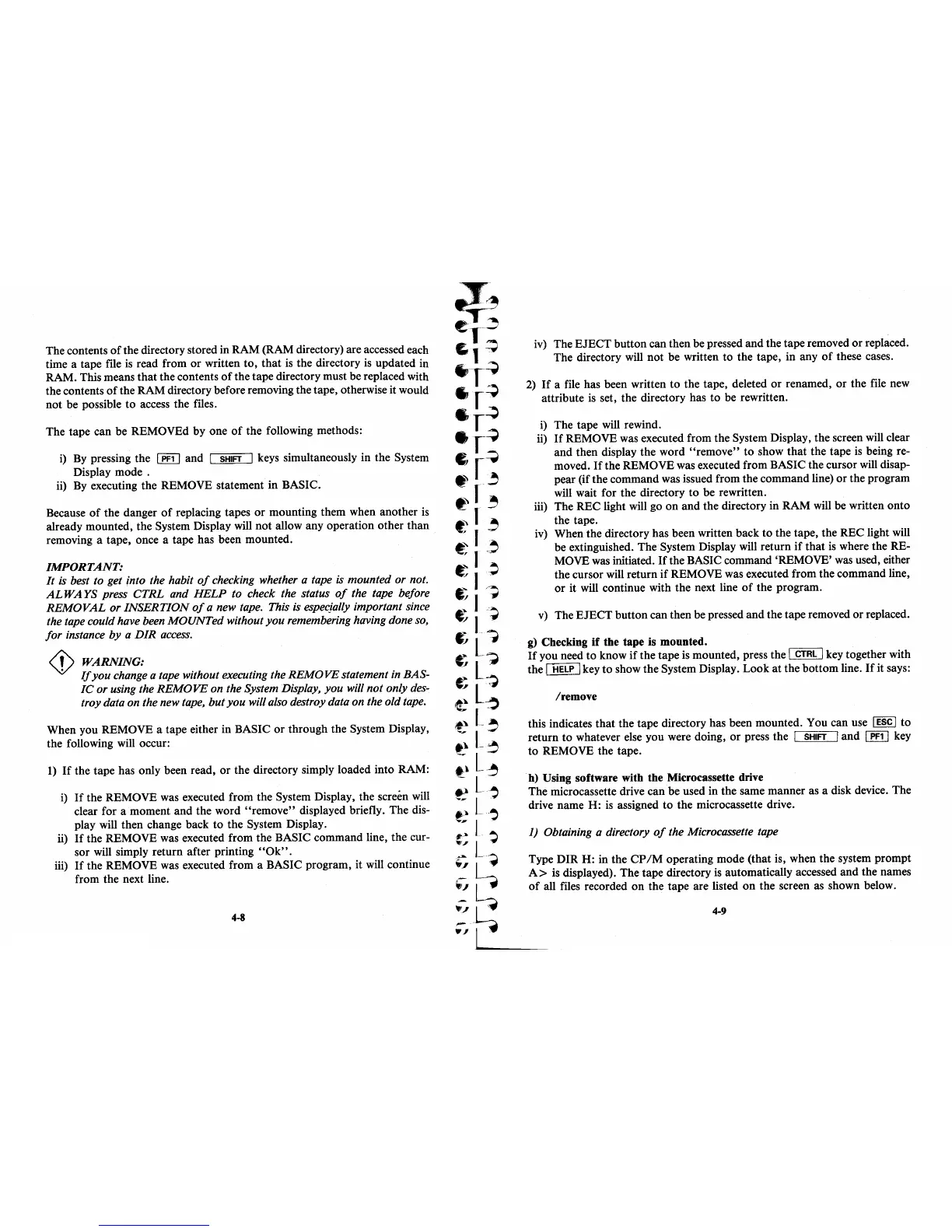The contents
of
the directory stored in RAM (RAM directory) are accessed each
time a tape file
is
read from
or
written to, that is the directory
is
updated in
RAM. This means that the contents
of
the tape directory must be replaced with
the contents
of
the RAM directory before removing the tape, otherwise it would
not be possible to access the files.
The tape can be REMOVEd by one
of
the following methods:
i)
By
pressing the
~
and I
SHIFT
I keys simultaneously in the System
Display mode .
ii)
By
executing the REMOVE statement in BASIC.
Because
of
the danger
of
replacing tapes
or
mounting them when another
is
already mounted, the System Display will not allow any operation other than
removing a tape, once a tape has been mounted.
IMPORTANT:
It
is best to get into the habit
of
checking whether a tape is mounted or not.
AL
WA YS press
CTRL
and
HELP
to check the status
of
the tape before
REMOVAL
or
INSERTION
of
a new tape. This
is
especjally important since
the tape could have been MOUNTed without you remembering having done so,
for
instance
by
a DIR
access.
<!>
WARNING:
If
you change a tape without executing the
REMOVE
statement in BAS-
IC
or using the
REMOVE
on the System Display, you will not only
des-
troy data on the new tape, but you will also destroy data on the old tape.
When you REMOVE a tape either in BASIC
or
through the System Display,
the following will occur:
1)
If
the tape has only been read,
or
the directory simply loaded into RAM:
i)
If
the REMOVE was executed from the System Display, the screen will
clear for a moment and the word
"remove"
displayed briefly. The dis-
play will then change back
to
the System Display.
ii)
If
the REMOVE was executed from the BASIC command line, the cur-
sor will simply return after printing
"Ok".
iii)
If
the REMOVE was executed from a BASIC program, it will continue
from the next line.
4-8
iv)
The EJECT button can then be pressed and the tape removed or replaced.
The directory will not be written to the tape, in any
of
these cases.
2)
If
a file has been written to the tape, deleted or renamed, or the file new
attribute
is
set, the directory has
to
be rewritten.
i)
The tape will rewind.
ii)
If
REMOVE was executed from the System Display, the screen will clear
and then display the word
"remove" to
show that the tape
is
being re-
moved.
If
the REMOVE was executed from BASIC the cursor will disap-
pear (if the command was issued from the command line) or the program
will wait for the directory to be rewritten.
iii) The REC light will go
on
and the directory in RAM will be written onto
the tape.
iv) When the directory has been written back to the tape, the REC light will
be extinguished. The System Display will return
if
that
is
where the RE-
MOVE
was
initiated.
If
the BASIC command 'REMOVE'
was
used, either
the cursor will return
if
REMOVE was executed from the command line
or
it will continue with the next line
of
the program. '
v)
The EJECT button can then be pressed and the tape removed or replaced.
g)
Checking
if
the tape is mounted.
If
you need to know
if
the tape
is
mounted, press the I CTRL I key together with
the
I HELP I key
to
show the System Display. Look
at
the bottom line.
If
it
says:
/remove
this indicates that the tape directory has been mounted. You can use
I
ESC
I to
return
to
whatever else you were doing,
or
press the I
SHIFT
I and
[fill
key
to
REMOVE the tape.
h) Using software with the Microcassette drive
The microcassette drive can be used in the same manner as a disk device. The
drive name H:
is
assigned to the microcassette drive.
1)
Obtaining a directory
of
the Microcassette tape
Type DIR H: in the
CP/M
operating mode (that is, when the system prompt
A>
is
displayed). The tape directory
is
automatically accessed and the names
of
all files recorded
on
the tape are listed
on
the screen as shown below.
4-9

